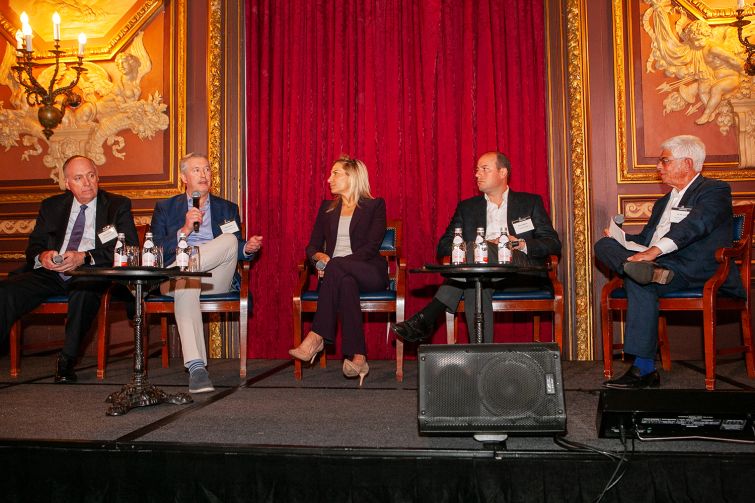Spring Finance Forum 2024: CRE Financiers Eye Signs of Recovery
Commercial real estate finance experts weighed in on the state of the debt markets at the annual New York event.
By Andrew Coen and Brian Pascus May 9, 2024 11:00 am
reprints
The weather in Manhattan was sunny with temperatures in the 70s on May 7 during Commercial Observer’s eighth annual Spring Finance CRE Forum, which attendees no doubt hope signals brighter days ahead for a commercial real estate market that has battled icy conditions the last two years.
The annual CO event was held six days after the Federal Reserve held interest rates steady with no indication of when borrowing conditions may begin to ease after 12 hikes were implemented by the central bank from March 2022 to July 2023. However, lenders and brokers who spoke at the forum inside the Metropolitan Club of New York voiced plenty of optimism that a recovery for the CRE market was around the corner.
“You’re starting to see the early signs of recovery within the real estate capital markets,” said Tim Johnson, global head of real estate debt strategies at Blackstone (BX) during opening remarks discussion moderated by Cathy Cunningham, CO’s executive editor. “It feels to me and to us at Blackstone that we’re generally on a path toward recovery.”
While the Fed is expected to keep interest rates higher for longer than what was initially anticipated entering 2024, Johnson stressed that market confidence of rates peaking has helped spur more financing activity this year, as evident by credit spreads tightening with commercial mortgage-backed securities (CMBS) deals. He added that a prolonged period of owners holding onto assets will likely result in more transaction volume as investors seek some for opportunities for “capital recycling”
Among asset classes, Blackstone is sticking to its high conviction themes of industrial and multifamily lending with a particular focus of late on data centers given technological demands like artificial intelligence driving the sector, according to Johnson. He noted though that, even with healthy performing sectors, Blackstone is careful to “pick and choose” which properties to target based on geographic areas with strong population drivers.
The office sector remains severely challenged four years after the COVID-19 pandemic unleashed increasing remote-work trends, but Johnson said there are pockets of opportunities on the lending side in certain submarkets like Manhattan’s Park Avenue, where occupancy levels are strong for newer Class A properties.
“I think you could see us dip our toes a bit more into lending on high-quality office buildings in geographies where fundamentals are pretty strong given a lack of supply in some of these core markets,” Johnson said. “There is clearly a subset of tenants out there that feel like they need to be in the office and are gravitating toward some of these high-performing submarkets.”
While some modern office buildings are managing to thrive despite continued headwinds from COVID, there remains a myriad of challenges for the overall market with older Class B properties resulting in wider bid-ask spreads.
Indeed, the uncertainty around valuations in office and other property types is one of the biggest differences between the current market location and what transpired with the CRE industry during the Global Financial Crisis, according to Rob Verrone, principal at Iron Hound Management, which specializes in CMBS restructurings.
“Back then there wasn’t as much of a gray area on what the property is worth,” said Verrone during a fireside chat moderated by Tony Fineman, head of originations at Acore Capital. “Now with remote work and with taxes and insurance through the roof, and then the politics that are going on and no-eviction [rules], no one knows what the property is worth and it’s hard to convince someone unless they have a real upside-down tax position to throw a bunch of money in on black and restructure a deal.”
Verrone, who was previously a CMBS lender at Wachovia before co-founding Iron Hound with Chris Herron in 2009, said workouts have become harder to get done in the current market due to bid-ask spread dynamics, with the process now taking around nine months for the average deal. He said he prefers to close modifications with a private individual or family office than the larger firms that have third-party investors that can often complicate ironing out key details.
There has been some progress of late in steering the CRE market toward a better future, but not enough to open the floodgates due to persistent elevated interest rates and a “steeper” forward curve, according to Dennis Schuh, chief originations officer at Starwood Capital Group.
“You are only selling if you are forced to sell right now,” said Schuh during the third session panel titled “Real Estate Finance Forecast: Comfort Levels Amidst New Changes.”
“I think people do think real estate is for sale right now and they want to get in, but there’s still a pretty big bid-ask,” Schuh added.

Lauren Hochfelder, co-CEO and head of Americas at Morgan Stanley Real Estate Investments, said while she acknowledges that the majority of sellers may be forced, for preferred asset classes there can be depth of demand with multifamily assets trading at tighter yields than people realize. Hochfelder noted that her platform has managed to sell some multifamily assets with cap rates between 4 and 5 percent. She also pointed out that some industrial properties along the southern border are also attracting investor interest due to nearshoring trends.
“Where you have secular trends or mega trends propelling demand, I think you are seeing capital really go there,” Hochfelder said. “But the aperture of what people want to invest in has narrowed.”
The panel — moderated by Jay Neveloff, partner and chair, real estate, at Kramer Levin Naftalis & Frankel — also featured Morris Betesh, senior managing director at Meridian Capital, and Sten Sandlund, CEO of Willowbrook Partners, a newly formed private credit lending arm launched by Peebles Corporation.
Hochfelder stressed the importance of not painting every asset class with a “broad brush,” noting there are bright spots in the office sector globally such as Tokyo, which has an 88 percent utilization rate, and Seoul at 94 percent. She noted that even in San Francisco – a market that has seen material declines in rents and values since pre-COVID times – Morgan Stanley’s office assets are garnering higher rents today than before COVID, as tenants have consolidated into renting “the best of the best properties”.
The panelists concurred that financing sources for deal flow in 2024 will largely be centered around private lenders given the highly regulated environment facing banks coupled with higher interest rates.
“After coming out of a crisis, usually the water has to be really warm for some of those traditional sort of lenders to creep back in, so I think they will be slow like they were coming out of the GFC,” Schuh said.
Insurance capital is undoubtedly playing an increased role filling the lending void of late with the line between debt funds and insurance companies becoming increasingly “blurred,” according to Nishant Nadella, head of single-asset, single-borrower and transitional lending at 3650 REIT. Nadella noted that Insurance funds managed by asset management firms have soared from $200 billion to $800 billion in the last six years, which does not even account for 3 percent of the global insurance market.
“If you look at where the market is going, it seems like it’s going to be insurance dominated and it’s going to be run by folks who get large insurance allocations or reinsurance allocations, and allocate 20 percent to real estate,” Nadella said during the forum’s fourth session in a panel titled “Shifting Lender-Borrower Dynamics & Getting Capital Stacks in Line”
Matt Pestronk, co-managing partner at Post Brothers, noted that insurance companies have an advantage now over banks in terms of driving more CRE capital in the current climate since they can sell five-year annuities that are attractive to investors amid higher interest rates. He said the trend is in the “early stages” and is “growing at an incredibly fast pace.”
The panel — moderated by Kathleen Mylod, partner at Dechert — also included Elliot Markus, vice president in the real estate private credit group at Cerberus Capital Management; Adam Schwartz, senior managing director at Walker & Dunlop; and Adam Piekarski, co-head of real estate credit at BDT & MSD Partners.
Markus stressed that with around $900 million in looming CRE loan maturities on tap this year, surviving for another day is the key, but comes with risks if interest rates aren’t reduced soon.
“Everyone is trying to survive to buy time and hope that rate cuts come so they can salvage some equity,” Markus said. “The game theory of that isn’t it doesn’t come. What ends up happening is that sponsors think their equity is sunk cost and they move on, or is there opportunity for people who’ve been patient with the capital? And all of that is TBD.”
After a short networking break, Goldman Sachs (GS)’ Siddharth Shrivastava, managing director of investment banking, held court during a fireside chat with Joseph Lanzkron, partner at Cleary Gottlieb Steen & Hamilton, where he made it clear to attendees that much of the pain commercial real estate has experienced since 2020 is now largely in the rearview mirror.
Shrivastava noted that capital markets in 2024 have seen “a lot of activity in CMBS markets.” Yet despite only $40 billion in CMBS securitization originating across the system in 2023, the first quarter of 2024 saw $20 billion, he said, and “in one quarter we traded half of what was done last year.”
He also pointed out that while refinancings have dominated Goldman Sachs’ real estate activity thus far in 2024, some of the nation’s biggest asset managers — Blackstone, Brookfield (BN) and KKR (KKR) — have made major acquisitions in recent months, and that his own bank is providing an increased amount of credit financed compared to 2023.
“You’re seeing acquisitions start with clients requiring commitments, and now you’re seeing an environment where commitments can once again be done,” Shrivastava said. “The overarching thing in all of these is we’re doing it for our best sponsors, our best clients, and so [for them] we’re certainly open to deploying our balance sheet and that’s how we’re thinking about opportunities that come to us.”
He even hinted that office — no joke — is now attracting CMBS financing after carrying the scarlet letter of shame across CRE since the pandemic hit.
“We are getting office deals in the CMBS market, there’s conduit deals, there’s been SASB, so that’s been a change in the office side,” Shrivastava said. “The environment for office financing is slightly better than it was last year. And if rates come down and keep coming down, the spigot of office that’s financeable will open up more and more.”
The optimism about the market continued during the next panel, where four executives at top investment firms pondered whether the pullback of the traditional banking sector away from CRE lending has inaugurated a golden age of private credit. Mark Fawner of Greenspoon Marder moderated.
“Time will tell,” said Yorick Starr, managing director and investment officer at Invesco. “The retrenchment of banks and some other capital that’s provided here has made the setup an interesting one to sort of be lending at overleverage with great sponsors in great markets.”
Starr noted that his firm originated $900 million in CRE loans last year but has already hit that total in the first quarter of 2024. “We’re looking at the more distress opportunities out there, not that there’s a whole lot of them, but that’s kind of the opportunity set we’ve found that’s interesting and available to be putting out a lot of capital for use,” he added.
Mark Silverstein, senior managing director at NewPoint Real Estate Capital, oversees the firm’s proprietary lending products. He said agency lending has increased during a time of high interest rates, as agencies are willing to lend at rates even lower than attractive CMBS financing. And if you can lend at a low rate, he noted, you can obviously lend with a little more leverage.
“Agencies have been very stable, and they’ve been available for large deals and small deals,” said Silverstein. “They love affordable [housing] and if there’s some affordable component or a green component [in there], the agencies will lean in and drive pricing that will be significantly better.”
Robert Rothschild, senior vice president at InterVest Capital Partners, added that while the current market has good fundamentals, there’s been a break in the capital stack for many assets. With the increase in interest rates, sponsors aren’t able to refinance on deals that they put out in 2021 — creating sizable holes in loans where agencies might have lent at 55 percent loan-to-value, and debt funds might have lent at a 75 percent loan-to-value clip, he said.
“There’s an opportunity to provide gap finance, to fill that hole between refinancing a floating-rate multifamily loan into an agency deal,” said Rothschild. “That opportunity won’t be around forever. As interest rates ultimately start to come down, those borrowers will get bailed out and be able to refinance and put in only a little bit of equity as opposed to 20 percent of the capital stack.”
Finally, Laura Rapaport, CEO and founder of North Bridge, broke down the intricacies of C-PACE lending, a form of fixed-rate lending that has historically been used to pay for energy-efficient improvements in commercial buildings.
Today, Rapaport noted, C-PACE lending has been turned into “a very effective credit product,” as it’s priced off the 10-Year Treasury at a fixed rate upon closing and usually carries a duration of 20 to 30 years, which allows it to be flexibly used not just for green renovations, but also to finance construction loans, refinancings, rescue capital, and synthetic A notes.
“We’re coming in and working with lenders at TCO [temporary certificate of occupancy] takeouts as an alternative to bridge financing,” she said. “Our biggest hurdle is lack of knowledge of how to use it. People are still figuring it out.”
The final panel of the morning, moderated by Cole Shotz‘s Leo Leyva, examined lender appetite across asset classes. Contrary to popular opinion, there is an appetite out there to lend on older assets, even office.

Michael Hoffenberg, founder and managing principal of Trevian Capital, said his firm “loves the `70s and `80s vintage stuff that no one else wants,” namely vintage workforce housing, strategic retail, older student housing and medical office.
“We’ll take what’s boring and falls into our space,” he said. “We’re going where others won’t, we’re charging a modest premium for it, and we’re helping borrowers get from point A to point B.”
Zach Hoffman, director of AllianceBernstein, admitted that his firm is spending time in the office space, as he views it as overlooked, but stressed that he’d rather place capital into the ever-dependable multifamily space.
“Relative to office, we’re spending time, as everyone else is, in the multifamily space,” he said. “We have a fixed-rate mandate from our parent, Equitable, and so we put out a significant amount of capital in that asset class. Most of that is kind of a bridge to a better capital markets environment.”
Catherine Chen, managing director of real estate assets at Apollo Global Management (APO), reminded the audience that while her private equity firm’s loans run the spectrum of $30 million to $900 million (and even $1 billion), every deal and transaction is nuanced due to lending ratios and property types. Citing an example, Chen said a $40 million fixed-rate loan with a longer duration is far different than a $40 million loan carrying binary leasing risk, where if things go great the lender gets repaid in 18 months, but if they don’t then they’re stuck with the property for five years.
To this end, her team originates across multiple vehicles that can do a combination of fixed-rate and floating-rate debt, where she’s found a healthy appetite for multifamily, industrial and retail lending in 2024. However, she caveated this binary lending strategy by emphasizing that base rates haven’t yet hit that anticipated forward curve that makes floating-rate debt so attractive.
“If you have the cash flow to support debt service, even if it’s interest-only, I think the cost to get that financing done in our fixed-rate bucket is much more attractive than on the floating-rate side,” she said. “If you look at relative value where we can offer on a portfolio side, as well as pricing from a borrower perspective, fixed-rate ends up being more attractive from a relative value, if you have the asset that can qualify for it.”
Max Herzog, executive managing director IPA Capital Markets, said there’s liquidity in the market today for “all asset classes,” even hospitality, which he described as “overlooked, more expensive capital.”
However, Herzog put a damper on the idea that office conversions will be the white knight for a beleaguered sector struggling with millions of square feet of antiquated, out-of-date space threatened by record vacancies.
“There’s going to be more conversions than we’ve ever seen over these next two years, but not as many as people think,” said Herzog. “You need to have the right layout, you have to be vacant, a lot needs to make sense for these conversions to happen — it might take care of some part of the office problem, but nowhere near as much as we might hope.”
Andrew Coen can be reached at acoen@commercialobserver.com and Brian Pascus can be reached at bpascus@commercialobserver.com


